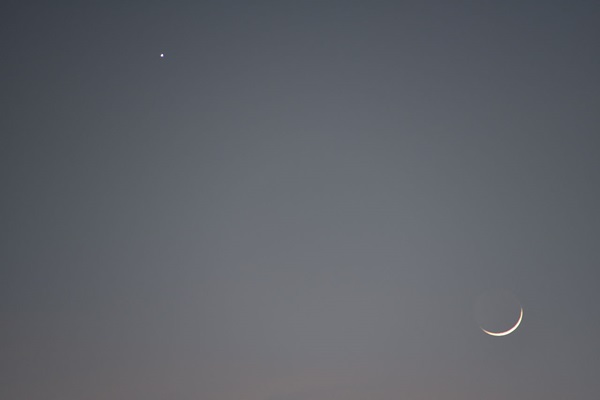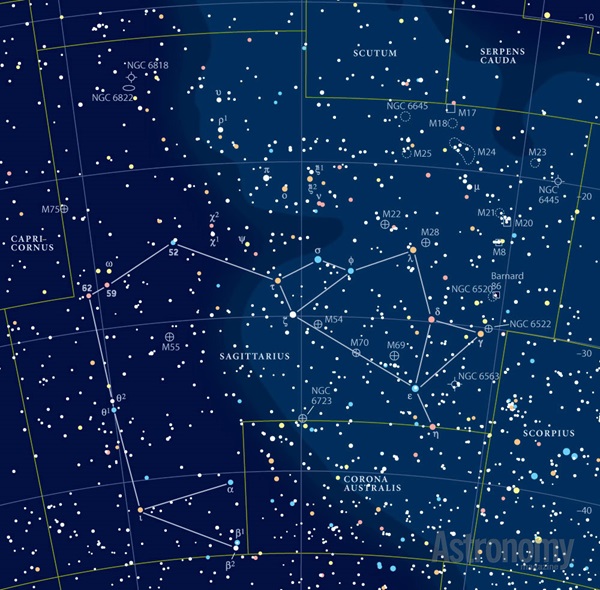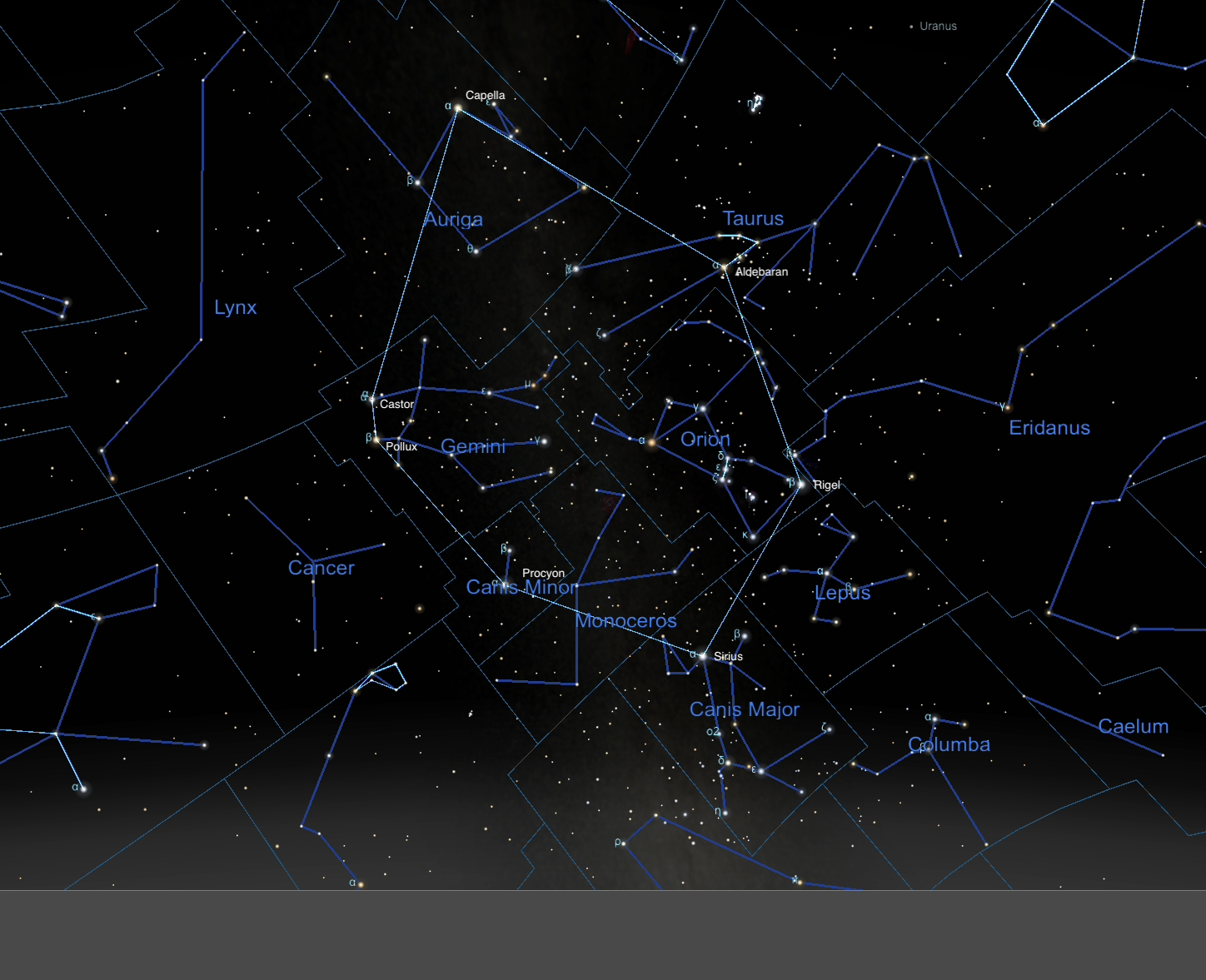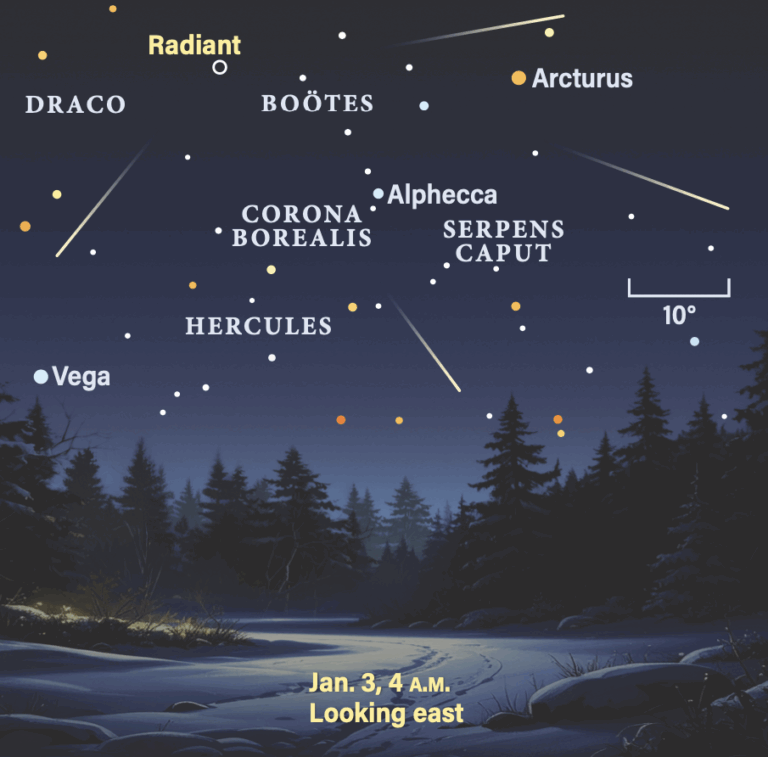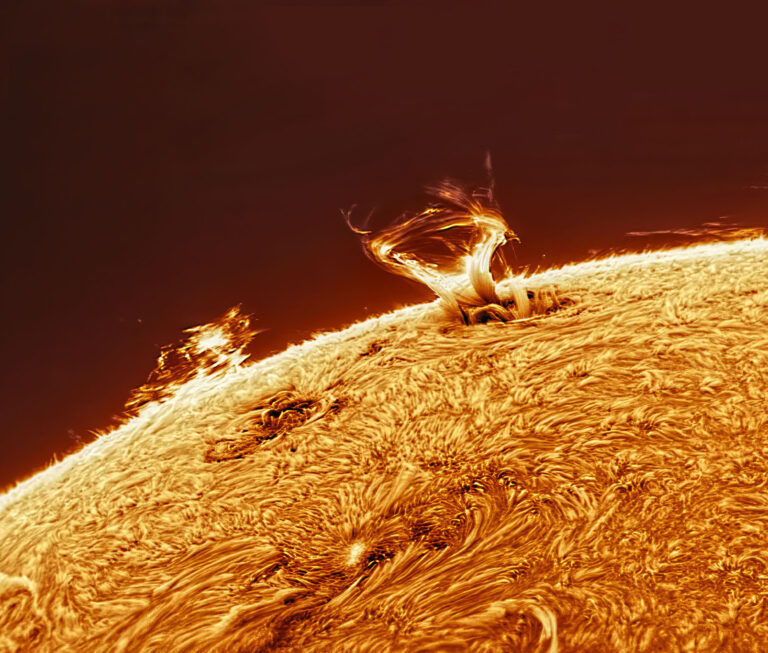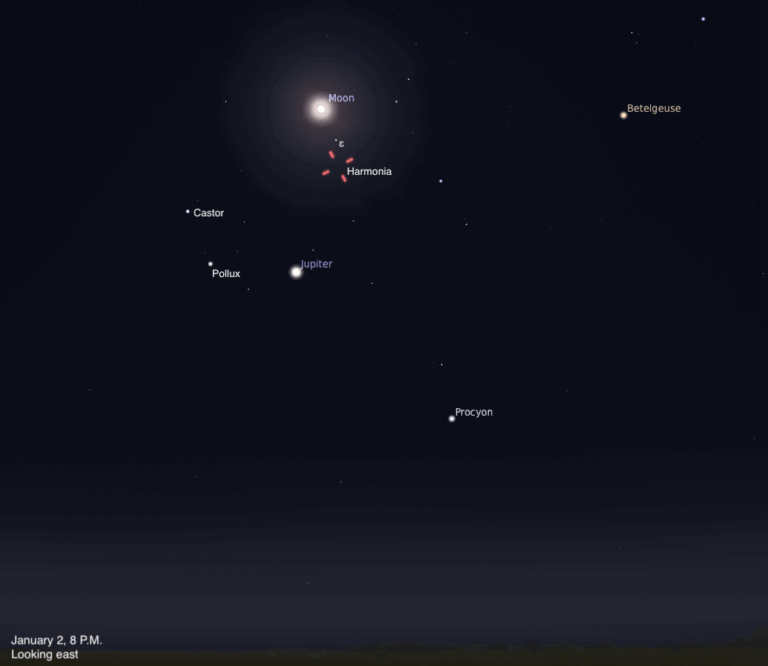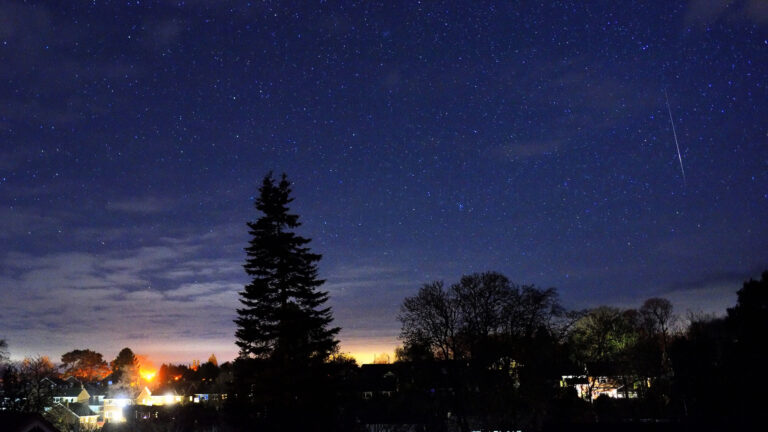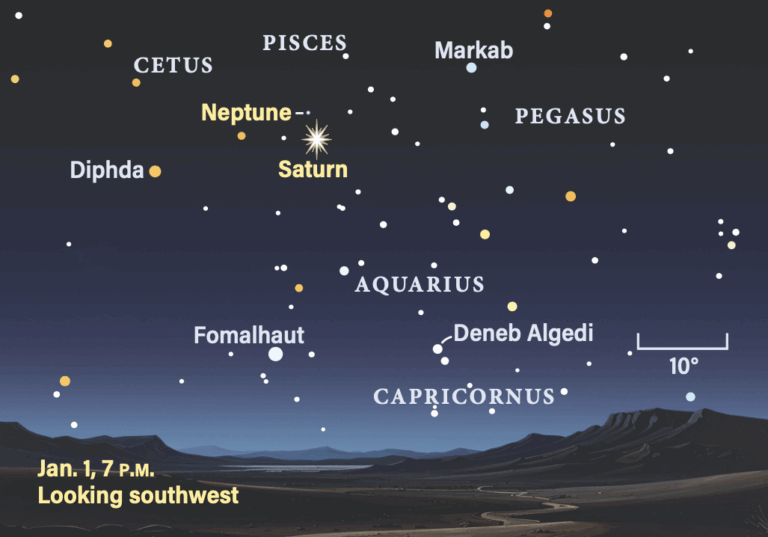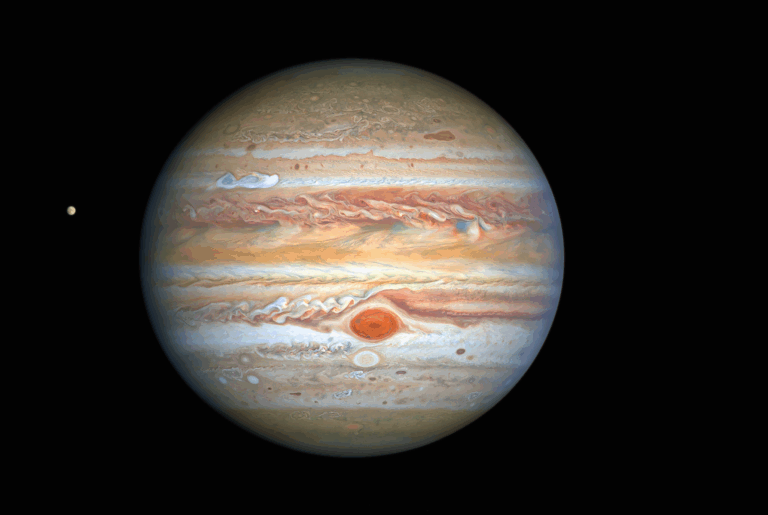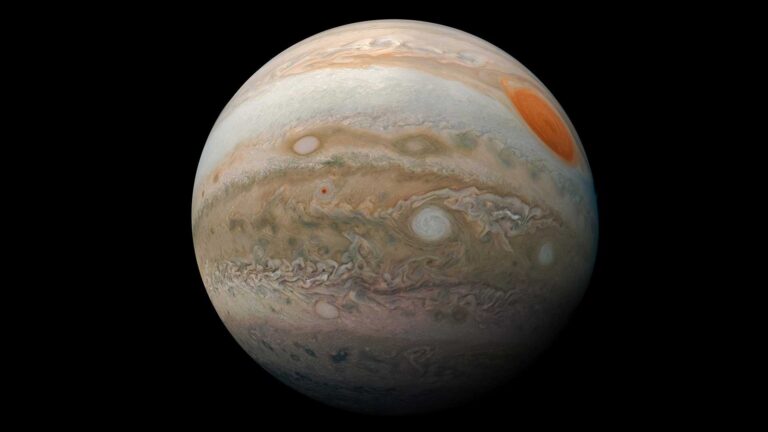Key Takeaways:
Friday, September 22
With the days growing shorter and kids back in school, it shouldn’t be surprising that summer’s reign is just about over. The warmest season comes to an official close at 4:02 p.m. EDT, when Earth reaches the autumnal equinox. This marks the moment when the Sun crosses the celestial equator traveling south. Our star rises due east and sets due west today. If the Sun were a point of light and Earth had no atmosphere, everyone would get 12 hours of sunlight and 12 hours of darkness. But the air and finite size of our star make today a few minutes longer than 12 hours.
The Moon appears as a waxing crescent low in the west-southwest during evening twilight. Tonight, you can use it as a guide for finding Jupiter. Although the gas giant planet has been a conspicuous evening object for the past several months, it’s now nearing the end of its reign. The giant planet lies 8° to the lower right of the Moon but just 6° above the horizon a half-hour after sundown. Still, at magnitude –1.7, Jupiter shines brightly enough to appear prominent against the twilight glow.
Saturday, September 23
The variable star Algol in Perseus reaches minimum brightness at 2:56 a.m. EDT. Observers on the East Coast who start watching around midevening on the 22nd can see the star’s brightness diminish by 70 percent over the course of about five hours. Those in western North America will see Algol brighten noticeably from late evening until dawn starts to paint the sky, when the star passes nearly overhead. This eclipsing binary system runs through a cycle from minimum (magnitude 3.4) to maximum (magnitude 2.1) and back every 2.87 days.
Sunday, September 24
Any clear evening this week is a good time to explore the constellation Sagittarius the Archer. This star group lies just west of due south as twilight ends around 8:30 p.m. local daylight time. The brightest stars within the constellation form a distinctive asterism in the shape of a teapot. The central regions of the Milky Way pass through Sagittarius, so it’s always worth exploring the region through binoculars or a telescope.
Monday, September 25
The waxing crescent Moon sets shortly after 10 p.m. local daylight time, and its absence from the morning sky these next 10 days provides observers with an excellent opportunity to view the zodiacal light. From the Northern Hemisphere, early autumn is the best time for viewing this elusive glow before sunrise. It appears slightly fainter than the Milky Way, so you’ll need a clear moonless sky and an observing site located far from the city. Look for a cone-shaped glow that points nearly straight up from the eastern horizon shortly before morning twilight begins (around 5 a.m. local daylight time at mid-northern latitudes). The Moon remains out of the morning sky until October 4, when the waxing gibbous world returns and overwhelms the much fainter zodiacal light.
Tuesday, September 26
You can use the waxing crescent Moon as a guide for finding Saturn this evening. The Moon stands out in the southwestern sky as darkness falls, while the ringed planet appears as a bright point of light just 3° below it. The two hang nearly 25° above the horizon around 8 p.m. local daylight time. Although this conjunction looks best with naked eyes or binoculars, it’s always worth targeting Saturn through a telescope. This week, the planet’s globe measures 16″ across while its spectacular ring system spans 37″ and tilts 27° to our line of sight.
Wednesday, September 27
First Quarter Moon occurs at 10:54 p.m. EDT. When the Sun sets this evening for North American observers, the half-lit Moon appears due south and one-third of the way from the horizon to the zenith. As darkness descends, our satellite grows more prominent against the background stars of northern Sagittarius, above that constellation’s Teapot asterism.
The Moon reaches apogee, the farthest point in its orbit around Earth, at 2:50 a.m. EDT. It then lies 251,250 miles (404,348 kilometers) from Earth’s center.
Thursday, September 28
Uranus reaches opposition three weeks from today, but it already has become a tempting evening target. The ice giant world rises before twilight ends and climbs nearly 30° above the eastern horizon by 10 p.m. local daylight time. The magnitude 5.7 planet lies in Pisces, 1.2° northwest of magnitude 4.3 Omicron (o) Piscium. Although Uranus glows brightly enough to see with the naked eye under a dark sky, binoculars make the task much easier. A telescope reveals the planet’s blue-green disk, which spans 3.7″.
Friday, September 29
Although autumn arrived with the equinox a week ago, the Summer Triangle remains prominent in the evening sky. Look high in the west after darkness falls and your eyes will fall on the brilliant star Vega in the constellation Lyra the Harp. At magnitude 0.0, Vega is the brightest member of the Triangle. The second-brightest star, magnitude 0.8 Altair in Aquila the Eagle, lies some 35° southeast of Vega. The asterism’s dimmest member, magnitude 1.3 Deneb in Cygnus the Swan, stands about 25° east-northeast of Vega. For observers at mid-northern latitudes, Deneb passes through the zenith around 9 p.m. local daylight time, nearly an hour after the last vestiges of twilight disappear.
Saturday, September 30
Brilliant Venus rises around 5 a.m. local daylight time, shortly before morning twilight starts to paint the sky. The inner planet shines at magnitude –3.9 — far brighter than any other point of light in the night sky — and remains prominent even as twilight brightens the sky. A telescope reveals the planet’s 11″-diameter disk, which appears about 90 percent lit.
Sunday, October 1
About 15 minutes after Venus pokes above the eastern horizon this morning, Mars rises directly below it. The Red Planet shines at magnitude 1.8 — less than 1 percent as bright as its neighbor — though it still stands out nicely against the twilight glow. The two planets will edge closer to each other over the next few days in the run-up to a spectacular October 5 conjunction.

